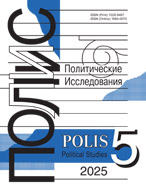Revisiting cleavage structures:
Islamic parties and nation-state formation in the Arab world
Kudryashova I.V.,
MGIMO University, Moscow, Russia, i.kudryashova@inno.mgimo.ru
elibrary_id: 626828 | ORCID: 0000-0003-1842-4672 |
Kozintsev A.S.,
MGIMO University, Moscow, Russia, kozintsev.a.s@my.mgimo.ru
elibrary_id: 1014407 | ORCID: 0000-0001-8037-1466 |
Article received: 2023.01.17. Accepted: 2023.03.07

DOI: 10.17976/jpps/2023.03.05
EDN: OIGRBM
Kudryashova I.V., Kozintsev A.S. Revisiting cleavage structures: Islamic parties and nation-state formation in the Arab world. – Polis. Political Studies. 2023. No. 3. https://doi.org/10.17976/jpps/2023.03.05. EDN: OIGRBM
The study was supported by the Russian Foundation for Basic Research, project No. 20-011-00922 а “Arab states after the ‘Arab Spring’: paths and dynamics of political transformations”.
Arab Spring, a series of pro-democracy uprisings that took place in the Middle East and North Africa, marked a new phase of Arab political process. Islamic parties and movements, struggling for equal access to the ballot, became an active participant in the mass protests and achieved significant electoral gains in a number of Arab countries. However, within a few years, ruling regimes managed to gradually suppress the opposition and remove Islamic movements from political arena or put them under state control. In some Arab countries, the prolonged crisis has led to an upsurge in violence and the collapse of government institutions. Do these disappointing results indicate no political prospects for the Islamic parties? In other words, is the activity of such organizations consistent with the nation-state project implemented in the region? We attempt to find answers to these questions by applying comparative and historical sociology analysis. We use as our main analytical tool Lipset and Rokkan cleavage theory that links the structure of socio-political conflicts in Europe with the logic of party system formation. We also believe the centre-periphery framework developed by Rokkan has explanatory value for the analysis of the Arab state and political parties’ formation. In this study, we propose two hypotheses: (i) the statechurch and centre-periphery divisions play a major role in the hierarchy of cleavages in Arab societies (in Arab cultural and political contexts, the former emerges as the divide between the country’s nation-state project and so-called Islamic state model); (ii) the cumulative effect of these two cleavages continues to define the political agency of Islamic parties. To test these hypotheses, we analyse the institutional competition between the three political forms (empire, nation-state and Islamic state model) after the start of Tanzimat reforms in the Ottoman Empire and the politicization of social cleavages in the Arab states under the League of Nations mandate system. The study confirmed the explanatory potential of the above-mentioned concepts in a non-Western socio-political environment; the hypotheses put forward were verified, and the topic was further developed. In particular, we have noted that due to their links with the Muslim communities and the polysemantic language of the Qur’an, Islamic parties have been able to reconceptualize urban-rural, workers-owners and newer cleavages.
References
Abbasi, R. (2020). Did premodern Muslims distinguish the religious and secular? The ‘Din–Dunya binary in the medieval Islamic thought. Journal of Islamic Studies, 31(2), 185-225. https://doi.org/10.1093/jis/etz048
Ayubi, N.N. (1999). Over-stating the Arab state: politics and society in the Middle East. London, New York: I.B. Tauris Publishers.
Al-Banna, H. (2009). Toward the light. Princeton readings in Islamist thought. In R.L. Euben, & M.Q. Zaman (Ed.), Texts and Contexts from Al-Banna to Bin Laden (pp. 56-78). Princeton, Oxford: Princeton University Press.
Bartolini, S., & Mair, P. (2007). Identity, competition and electoral availability: the stabilisation of European electorates 1885-1985. ECPR Press.
Bornschier, S. (2009). Cleavage politics in old and new democracies. Living Reviews in Democracy. October. URL: https://cis.ethz.ch/research/living-reviews-in-democracy.html
Cavatorta, F., & Clark, J.A. (2022). Political and social mobilization in the Middle East and North Africa after the 2011 uprisings. Globalizations, 1-14. 10.1080/14747731.2021.2012910
Cavatorta, F., & Storm, L. (Ed.). (2018). Political parties in the Arab world: continuity and change. Edinburgh: Edinburgh University Press.
Cesari, J. (2020). Religion, state and nation: Islamic parties between ideology and religion. In J. Haynes (Ed.), The Routledge Handbook to Religion and Political Parties (pp. 31-42). Abingdon, New York: Routledge.
Dawisha, A. (2005). Democratic attitudes and practices in Iraq, 1921-1958. Middle East Journal, 59(1), 11-30.
El Kyak, A. (2018). The institutionalisation of Islamist political parties after the uprisings. In F. Cavatorta, L. Storm (Ed.), Political Parties in the Arab World: Continuity and Change (pp. 72-99). Edinburgh: Edinburgh University Press.
Hafez, K. (2010). Radicalism and political reform in the Islamic and Western worlds. New York: Cambridge University Press.
Hinnebusch, R. (2017). Political parties in MENA: their functions and development. British Journal of Middle Eastern Studies, 44, 1-17.
Hooghe, L., & Marks, G. (2018). Cleavage theory meets Europe’s crises: Lipset, Rokkan, and the transnational cleavage. Journal of European Public Policy, 25(1), 109-135.
Ghafar, A.A., & Hess, B. (2018). Islamist parties in North Africa: a comparative analysis of Morocco, Tunisia and Egypt. Doha: Brookings Doha Center.
Joya, A. (2018). Is Islamism accommodating neo-liberalism? The case of Egypt’s Muslim brotherhood. In H. Kraetzschmar, & P. Rivetti (Ed.), Islamists and the Politics of the Arab Uprisings: Governance, Pluralisation and Contention (pp. 89-106). Edinburgh: Edinburgh University Press.
Kao, K. (2022). Electoral institutions and identity based clientelism in Jordan. Political Research Quarterly. https://doi.org/10.1177/10659129221128752
Islamists and the politics of the Arab uprisings: governance, pluralisation and contention. Ed. by H. Kraetzschmar, P. Rivetti. Edinburgh: Edinburgh University Press.
Karpat, K. (Ed.). (1982). Political and social thought in the contemporary Middle East. Westport: Praeger.
Karpat, K. (1988). The Ottoman ethnic and confessional legacy in the Middle East. In M.J. Esman, & I. Rabinovich (Ed.), Ethnicity, Pluralism, and the State in the Middle East (pp. 35-53). Ithaca, London: Cornell University Press.
Karpat, K. (2001). The Politicization of Islam: Reconstructing Identity, State, Faith, and Community in the Late Ottoman State. New York: Oxford University Press.
Khoury, Ph.S. (2003). Urban notables and Arab nationalism: the politics of Damascus 1860-1920. Cambridge: Cambridge University Press.
Lewis, B. (1988). The political language of Islam. Chicago, London: The University of Chicago Press.
Lipset, S.M., & Rokkan, S. (1967). Cleavage structures, party systems, and voter alignments: an introduction. In S.M. Lipset, & S. Rokkan (Ed.), Party Systems and Voter Alignments: Cross-National Perspectives (pp. 1-64). New York: Free Press.
Lust, E. (2009). Democratization by elections? Competitive clientelism in the Middle East. Journal of Democracy, 20(3), 122-135.
Migdal, J.S. (2001). State in society: studying how states and societies transform and constitute one another. New York: Cambridge University Press.
Milton, P., Axworthy, M., & Simms, B. (2019). Towards a Westphalia for the Middle East. New York: Oxford University Press.
Owen IV, J.M. (2015). Confronting political Islam: six lessons from the West’s past. Princeton N.J., Woodstock: Princeton University Press.
Pall, Z. (2018). Do Salafi parties represent a contradiction in terms? The development and fragmentation of Kuwait’s Salafi Islamic group. In F. Cavatorta, & L. Storm (Ed.), Political Parties in the Arab World: Continuity and Change (pp. 100-126). Edinburgh: Edinburgh University Press.
Rokkan, S. (1975). Dimensions of state formation and nation-building: a possible paradigm for research on variations within Europe. In Ch. Tilly (Ed.), The Formation of National States in Western Europe (pp. 562-600). Princeton, N.J.: Princeton University Press.
Rokkan, S. (1987a). Territorial structures in Western Europe: an overview and possible model. In Center Periphery Structures in Europe: An ISSC Workbook in Comparative Analysis (pp. 51-105). Frankfurt a. M.: Campus.
Rokkan, S. (1987b). The center-periphery polarity. In Center Periphery Structures in Europe: An ISSC Workbook in Comparative Analysis (pp. 17-50). Frankfurt a. M.: Campus.
Salvatore, A. (2015). Modernity. In G. Bowering (Ed.), Islamic Political Thought: An Introduction (pp. 135-151). Princeton, Woodstock: Princeton University Press.
Saouli, A. (2012). An Arab state: dilemma of late formation. New York: Routledge.
Sartori, G. (1970). Concept misformation in comparative politics. In The American Political Science Review, 64(4), 1033-1053.
Schwedler, J. (2018). Conclusion: new directions in the study of Islamist politics. In H. Kraetzschmar, & P. Rivetti (Ed). Islamists and the Politics of the Arab Uprisings: Governance, Pluralisation and Contention (pp. 359-374). Edinburgh: Edinburgh University Press.
Soleimani, K. (2016). Islam and competing nationalisms in the Middle East, 1876-1926. New York: Palgrave Macmillan.
Soysal, Y., & Strang, D. (1989). Construction of the first mass education systems in nineteenth-century Europe. Sociology of Education, 62(4), 277-288.
Spiegel, A.M. (2015). Young Islam. The new politics of religion in Morocco and the Arab world. Princeton: Princeton University Press.
al-Tahtawi, R.R. (2002). The extraction of gold, or an overview of Paris, and the honest guide for girls and boys. In Ch. Kurzman (Ed.), Modernist Islam, 1840-1940: a Sourcebook (pp. 31-39). N.Y.: Oxford University Press.
Wickham, C.R. (2013). The Muslim Brotherhood. Evolution of an Islamist movement. Princeton, Oxford: Princeton University Press.
Zollner, B. (2018). Does participation lead to moderation? Understanding changes in the Egyptian Islamist parties post-Arab Spring. In H. Kraetzschmar, & P. Rivetti (Ed.), Islamists and the Politics of the Arab Uprisings: Governance, Pluralisation and Contention (pp. 149-165). Edinburgh: Edinburgh University Press.
Zollner, B. (2021). The metamorphosis of social movements into political parties. The Egyptian Muslim Brotherhood and the Tunisian al-Nahda as cases for a reflection on party institutionalisation theory. British Journal of Middle Eastern Studies, 48(3), 370-387. https://doi.org/10.1080/13530194.2019.1609413
Zürcher, E.J. (2003). Turkey: a modern history. New York, London: I.B. Tauris.
Al’-Mawardi, Abu al’-Hasan Ali bin Muhammad bin Habib al’-Basri al’-Bagdadi. Al’-ahkam as-sultanija [The ordinances of government]. Cairo: Dar al’-Hadis. (In Arabic). https://waqfeya.com/book.php?bid=12388
Andzhum, O. (2018). Koncepcija halifata i ego budushhee [Concept of caliphate and its future]. Islamic Union. (In Russ.)
Bardin, A.L. (2021). Digital divide in the modern megapolis: political aspects. Polis. Political Studies, 6, 73-88. (In Russ.) https://doi.org/10.17976/jpps/2021.06.6
Bogomolov, S.A. (2019). «War Revolution» of Muhammad Ali in the Egypt in 1820s. Minbar. Islamic Studies, 12(3), 645-664. (In Russ.) https://doi.org/10.31162/2618-9569-2019-12-3-645-664
Grinin, L., & Korotayev, A. (2019). Islamizm i ego rol' v sovremennom islamskom obshhestve [Islamism and its role in modern Islamic societies]. Volgograd: Uchitel Publishing House. (In Russ.)
Ilyin, M.V. (2008). The formula of statehood. Politeia, 3, 67-78. (In Russ.)
Khayrullin, T. (2022). Trends in political Islam: transition towards liberalization. Social Sciences and Contemporary World, 1, 91-99. (In Russ.) https://10.31857/S0869049922010087
Kosach, G.G. (2016). Saudi Arabia: national unity without pluralization. Political Science (RU), 1, 60-79. (In Russ.)
Kosach, G.G. (2001). Krasnyj flag nad Blizhnim Vostokom? Kompartii Egipta, Palestiny, Sirii i Livana v 20-e – 30-e gody [Red flag above the Middle East? Communist parties of Egypt, Palestine, Syria and Lebanon from 1920s to 1930s]. Moscow: Moscow State University Publishing. (In Russ.)
Kozintsev, A.S. (2020). Institutionalization of Islamist parties in the process of nation-building: the case of the Moroccan Party of justice and development. Political Science (RU), 1, 258-280. (In Russ.) http://www.doi.org/10.31249/poln/2020.01.10
Kudryashova, I.V., & Kozintsev, A.S. (2021a). Institutional solutions for sectarian conflicts in the Middle East in the context of imperial legacy. Political Science (RU), 2, 140-164. (In Russ.) http://www.doi.org/10.31249/poln/2021.02.05
Kudryashova, I.V., & Kozintsev, A.S. (2021b). Islamic parties between sacred and profane: transformation of the concept of party in the Muslim political discourse. Politeia, 4, 63-80. (In Russ.) https://doi.org/10.30570/2078-5089-2021-103-4-63-80
Lapkin, V.V. (2021). Cleavages in territorial communities, internal consolidation of national states, and new challenges of extraterritoriality. South-Russian Journal of Social Sciences, 22(2), 6-20. (In Russ.) https://doi.org/10.31429/26190567-22-2-6-20
Levin, Z.I. (1988). Islam i nacionalizm v stranah zarubezhnogo Vostoka. Idejnyj aspect [Islam and nationalism the countries of the foreign East (ideological aspect)]. Moscow: Science. (In Russ.)
Murtazin, M.F. (2018). Islam and Islamism: a case study of the religion transforming into the politics. Outlines of Global Transformations: Politics, Economics, Law, 11(4), 190-205. (In Russ.) https://doi.org/10.23932/2542-0240-2018-11-4-190-205
Naumkin, V.V., & Kuznetsov, V.A. (2019). Deja vu: Medieval motifs in modern Arab political life. MGIMO Review of International Relations, 12(4), 38-53. (In Russ.) https://doi.org/10.24833/2071-8160-2019-4-67-38-53
Sadyhova, A., & Sadyhova, N. (2016). Musul'manskie reformatory v Zapadnoj Evrope: ot slavnogo proshlogo k neopredelennomu budushhemu [Reformist Muslims in Western Europe: from glorious past to uncertain future]. Perspektivy. (In Russ.) https://www.perspektivy.info/misl/cenn/musulmanskije_reformatory_v_zapadnoj_jevrope_ot_slavnogo_proshlogo_k_neopredelennomu_budushhemu_2016-12-13.htm
Salmin, A.M. (2005). The church, the state and politics in the Catholic world. Polis. Political Studies, 6, 147-171. (In Russ.) https://doi.org/10.17976/jpps/2005.06.10
Sapronova, M. (2018). Islamic political parties and the state. Asia and Africa Today, 11, 30-33. http://10.31857/S032150750001786-6
Semenenko, I.S., Lapkin, V.V., & Pantin, V.I. (2021). Social cleavages and political divides in a theoretical perspective: criteria for assessment and classification. Polis. Political Studies, 5, 56-77. (In Russ.) https://doi.org/10.17976/jpps/2021.05.05
Shumilin, A.I. (2022). The Muslim brotherhood in Europe: between religion and politics. Part 2. Scientific and Analytical Herald of Institute of Europe Russian Academy of Sciences, 2, 140-148. (In Russ.) http://dx.doi.org/10.15211/vestnikieran22022140148
Sjukijajnen, L.R. (1997). Shariat i musul'mansko-pravovaja kul'tura [Sharia and Islamic legal culture]. Moscow: State and Law Institute RAS. (In Russ.)
Surkov, N. (2020). The place of religious parties in the political systems of Arab countries. Islamovedenie. Vol. 11. No. 1. P. 26-37. https://doi.org/10.21779/2077-8155-2020-11-1-26-37
Tsaregorodtseva, I. (2017). The Islamists in politics in Egypt and Tunisia after ‘Arab Spring’. Islamology, 7(1), 122-137. (In Russ.) http://dx.doi.org/10.24848/islmlg.07.1.07
Vasiliev, A.M. (Ed.). (2019). Skhvatka za Blizhnii Vostok: regional'nye aktory v usloviyakh rekonfiguratsii blizhnevostochnogo konflikta [Battle for the Middle East: regional actors in the context of the reconfiguration of the Middle East conflict]. Moscow: LENAND. (In Russ.)
See also:
Korgunyuk Yu.G.,
Cleavage Theory and Theory of Issue Dimensions: Cross-Points. – Polis. Political Studies. 2019. No6
Korgunyuk Yu.G.,
The 2012-2014 Party Reform and the Structure of the Electoral Divides in Russia’s Regions. – Polis. Political Studies. 2015. No4
Lapkin V.V., Pantin V.I.,
Global Dynamics of Political Institutions in the Context of the Destabilizing World Order (cases of the EU and Russia). – Polis. Political Studies. 2020. No4
Patrushev S.V.,
The Modern World’s Arrangement. What We Have Learned and What We Should Like to Learn in the Epoch of Csisis. Listing One Book’s Pages. – Polis. Political Studies. 2009. No3
Semenenko I.S., Lapkin V.V., Pantin V.I.,
Social Cleavages and Political Divides in a Theoretical Perspective: Criteria for Assessment and Classification. – Polis. Political Studies. 2021. No5




.jpg)






 print
print
.jpg)
.jpg)